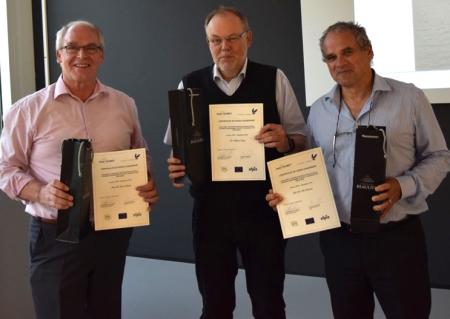
IMI Programme Office: Why was a project like yours needed in the first place?
Nico Vermeulen: In 2009, when we started with the preparation of this project, there was a need for education and training in drug discovery and drug development. So we decided to create an education and training platform with people from academia and the pharma industry. We wanted to come up with a curriculum dealing with drug discovery and development in its different stages – from molecule to patient.
Manfred Kansy: From the pharma industry perspective, it was also obvious that there were limited holistic training options for safety scientists available.
IMI Programme Office: Which project achievements are you most proud of?
Nico Vermeulen: It is remarkable that we succeeded within the first year already to put together a curriculum for 20 courses which were harmonised with each other. In the second year we already started giving the courses. It just amazes me that we managed to bring all these people together in one consortium, in one curriculum.
What I also liked about this project is that there are now several of my PhD students who are working with IMI industrial partners. This illustrates that we are preparing a new generation of students who can find jobs in the pharma industry.
Manfred Kansy: What is amazing is that in the three course cycles which we had, more than 800 people have been trained. I think this is quite an achievement.
IMI Programme Office: How did the pharmaceutical industry benefit from this project?
Manfred Kansy: The main benefit is that we got access to better trained colleagues in safety sciences who can quickly become operational on the job.
The network which was established within the project is also important because we now know where experts on specific topics of interest are and we can contact them when we have a need to organise internal trainings. We can also call on these experts in safety sciences in case of specific questions. We really gained a lot from this network.
IMI Programme Office: And how did the academic community benefit?
Nico Vermeulen: In academia we usually have our narrow areas of expertise, but in this programme we created a consortium of top experts in Europe with knowledge and insights into various aspects of drug safety sciences. In total there were 240 course leaders and teachers in our consortium, covering different areas of drug safety sciences. That was really interesting and insightful for us in academia. Secondly, if I look at my own PhD students, in a short period of time they become experts in drug safety sciences – this consortium allowed them to get that training. Thanks to that, they are better prepared for jobs in the pharma industry. This was really a response to what we all felt was a great need in the pharma sciences. The new experts which we trained will help us create new safe medicines faster than before.
IMI Programme Office: Do you think all this would have been possible to achieve without the public-private collaboration brought by IMI?
Nico Vermeulen: To be honest, we did not know that for sure in the beginning because IMI was just introduced as a public-private partnership. But while preparing the project proposal, we already saw that there is a lot of complimentary expertise in industry and academia, and we made quite efficient use of that complementarity during the course of the project. In all of our courses we had one academic and one industrial course leader, and we were really able to implement the complementarity into the system. For example in our courses we had many real-life case studies from the industry. The pharma industry partners (14 in total) were very loyal to the consortium and provided in-kind teachers for all the courses. Overall, 30-40 percent of our teachers were from the pharma industry. As academia alone, we would never have been able to create a consortium with this complementary expertise.
Manfred Kansy: I completely agree. There are specific workflows in pharma companies to deal with safety sciences. Courses on these subjects can hardly be covered by an academic institution alone that does not know how this works in practice. A project like this was only possible through collaboration between academia and the pharma companies.
